How do companies produce tie dye? Is it hand dyed? Done with template or machine?
How do companies produce tie dye? Is it hand dyed? Done with template or machine?
Name: Micah
Country or region: USA
Message: I have searched your site and it has proven very useful for information and data I will be using in a speech in a few days. Don't worry, properly cited it will be. I am still having trouble finding information on the mass production of tie dye though. I have done many searches and have found nothing on how companies produce tie dye. Is it hand dyed? Done with template or machine? I really don't know! This might be a bit out of your range of expertise but I just thought you might have more information than what I have found. Thank you for your time and consideration.
I can't give you much in the way of real information, only some speculation and a few observations.
There are many tie-dyes that are extremely repetitive in style and color, and very inexpensive. These most likely represent cheap labor in places such as China or India. They appear to be tied and have dyes squirted upon them, then untied and excess dye washed out, just as in the standard hand tie-dyeing technique, but there is no color blending and no variation in detail. Here are some examples of tie-dyes from Land's End that are tied and hand-dyed, but show no individuality:
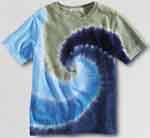
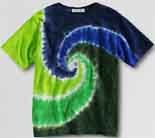
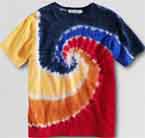
There is a remarkable degree of uniformity, but the shirts are dyed with decent reactive dyes and get good customer reviews. I don't know if there is such a thing as a machine that can tie shirts in a spiral and then squirt dyes on them; if there is, I'd imagine that these shirts must have been done that way, though the seller is reputable and is specifically claiming that these were hand-tied and hand-dyed. These do appear to have been tied, after having been twisted into a spiral, and then dyed by having dyes squirted on, but the extreme uniformity suggests the use of some sort of mechanical device for the twisting, to make it so identical from one shirt to another.
Single-color tie-dyes can be made by a much simpler technique. The shirts are tied in one of a handful of methods (stripes, spirals, or circles), then a great many of them are dropped into a single-color dyebath. Since there is less handwork required, and less skill, these are even cheaper to make, and don't require any machine to help with the tying. Also, since there is no problem with having a darker color on one part of the shirt run onto a lighter-colored region, there is no requirement for the more expensive fiber reactive dyes that are needed for multi-colored tie-dyes. Cheap and inferior direct dyes can be used, instead (though heating of the dyebath is required for direct dyes); if washfastness is very poor, as is common with direct dye, a cationic dye fixative can be used to correct the problem. The effect of a single-color tie-dye can be nice and subtle, and yet it's very easy to make. Note that the lighter-color bound regions of the shirts below are not identical in shape.
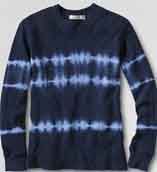
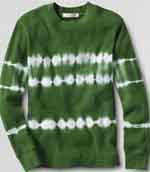
Many "tie-dyed" garments and other items are actually printed, never tied, and perhaps more likely to be colored with pigments than with dyes. For example, this towel at Land's End is claimed to be tie-dyed, but, according to a customer comment, there is color on only one side of the towel. This means that the towel was printed with a design, probably using pigments rather than true dyes, and certainly not tie-dyed at all. You can even note that every detail and every squiggle is exactly the same from one color scheme to the next, which could never happen in a real tie-dye.
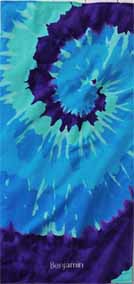
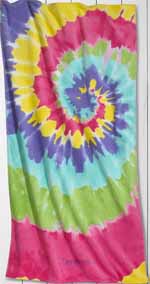
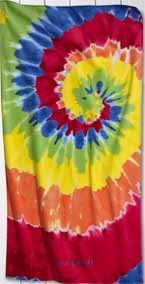
We can assume that the printed towels are much less expensive to make than similar hand-dyed towels could be.
Printed "tie dye" designs are not uncommon. Whenever you see tie-dyed bathing suits or rash guards, chances are that, while the original design may have been taken from tie-dyed fabric, the fabric you see in use was printed like any other printed nylon fabric. The same is obviously true of the various hard items with tie-dyed designs, anything from light switch cover plates to waste baskets. Even my kayak has a printed tie-dye-type design, in swirls of yellow, orange, and red.
For a different form of semi-mechanization, a few years ago someone described to me a form of mass-produced tie-dyeing he said he'd seen. He said that the usual good fiber reactive dyes were used, so the results were better than printed fabric made using a design drawn from a tie-dyed original, but instead of individual tieing and dyeing, a shirt was placed onto a sort of rack made of bars, which created a fold pattern, then a metal screen with holes pierced through it was positioned over it. Dye was then squeegeed across the top, in a form of screen printing. Next another screen was used to apply another color of dye. The web site on which these shirts are sold claimed, he said, that each shirt was unique, but it's the kind of unique that you get when one screen is positioned slightly to one side or the other due to lack of precision, rather than the uniqueness of something that has been individually tied. Prices were kept low by employing illegal immigrants to do the work, or so claimed the guy who told me this. I've never been able to confirm this method as actually being in use, though I have seen plenty of highly repetitive tie-dyes advertised for sale that could have been made by a similar technique.
Comparing those above to designs individually hand-dyed by master tie-dyers, and you will see big differences:
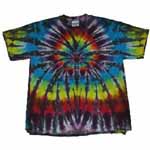
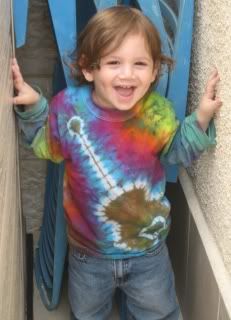



None of these could have been done by mass production or by unskilled low-paid workers. The difference is very striking.
(The example on the left is by Brad Garrett at Phat Dyes; the second image is by Elisheva Ben Ze'ev, posted on the Dye Forum; the third is by dyer THC, posted elsewhere on the Dye Forum ; the fourth is from True Tie Dye; and the fifth is by Judy Sall, at her ArtFire store.)
Tie dye can be a true art, but if volume is more important than quality, it becomes no more than a way to color large quantities of items with a minimum of labor, more interesting than solid colors, but nothing like the real art of tie-dye.
(Please help support this web site. Thank you.)
(Please help support this web site. Thank you.)
Posted: Monday - October 10, 2011 at 09:30 AM
Follow this blog on twitter here.
Quick Links
- All About Dyes & Dyeing Top -
- Top of this blog -
- FAQ -
- The Dye Forum -
- How to Tie Dye - How to Batik -
- Books - Toys - Plants -
- Top of this blog -
- FAQ -
- The Dye Forum -
- How to Tie Dye - How to Batik -
- Books - Toys - Plants -
More in this category:
- -
Statistics
Total entries in this blog:
Total entries in this category:
Published On: Aug 29, 2012 02:49 PM
Total entries in this category:
Published On: Aug 29, 2012 02:49 PM